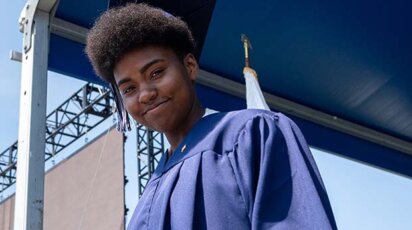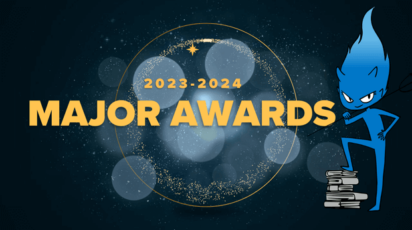News
InFInite STEM Spotlights Women Nobel Prize Winners
Perseverance and a passion for scientific discovery were characteristics of all the Nobel Prize-winning women scientists who were the subjects of presentations by students of InFInite STEM — a Poly group designed to encourage female-identifying students to go into science, technology, engineering, and mathematics (STEM) fields.
On November 13, teams of students presented brief biographies and reports about the work and accomplishments of Dr. Barbara McClintock, Dr. Andrea Ghez, Ada Yonath, Irène Joliot-Curie, Tu Youyou, Dr. Katalin Karikó, and May Britt-Moser for an audience in the library.
Before the presentations, Chair of Computer and Information Science Department Jean Belford P’24, ’30 asked Upper School chemistry teacher Gail Horowitz to introduce a special guest.
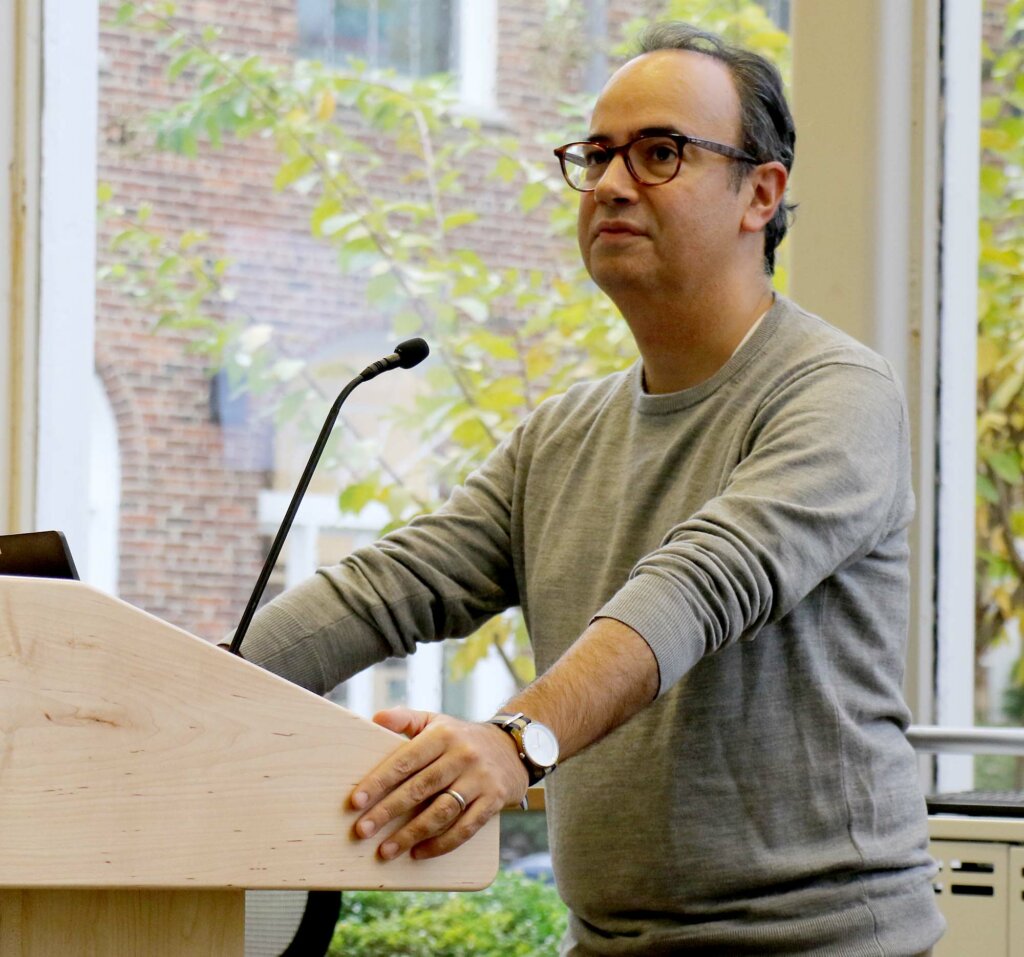
A Nobel Connection to Poly
Raoul Bhavnani P’27, the great nephew of Dr. McClintock, shared with the audience that she had ties to Brooklyn and that two of her nephews, Howard A. McKinley ’42 and Peter M. McKinley ’44 were Poly graduates.
“She was the only girl in her science and PhD classes and did not have time for a family,” he said. Dr. McClintock, a geneticist, “labored in relative obscurity for decades,” he said, and “everyone said she was wrong” about her research into maize cytogenetics. When she was recognized for her work with a Nobel Prize in 1983, she had no spouse or children to bring to the ceremony, so she “brought a 12-year-old boy,” Bhavnani said, “that boy was me!” He shared photos of the ceremony.
Presentations
Genetics – Barbara McClintock
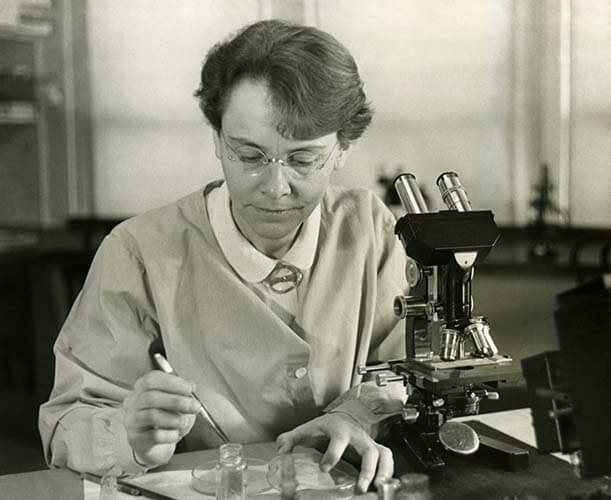
Lena Shamos ’25 and Samara Charles ’28 presented about Dr. McClintock explaining that she discovered that “genes can jump within the chromosome.” At the time she made this discovery, Dr. McClintock was not taken seriously. But “30 years later men found the same thing,” they said, and finally Dr. McClintock’s work was recognized and she was awarded the Nobel Prize for Physiology or Medicine “for her discovery of mobile genetic elements.”
Lilly Belford ’24 and Selena Wu ’25 also reported on Dr. McClintock and her study of maize cytogenetics and the “Theory of Genetic Transposition.” Cytogenetics is the study of chromosomes.
Chemistry – Ada Yonath
Madeline Gross ’26 and Annakaecia Clarke ’25 reported on Ada Yonath, an Israeli chemist, and her pioneering study of the “structure and function of ribosomes and how they make proteins.” Yonath was awarded the Nobel Prize in Chemistry in 2009.
Physics – Irène Joliot-Curie, Marie Curie, Andrea Ghez
Brianna Sylvain ’27 and Neeka Aghazadeh ’27 presented on chemist and physicist Irène Joliot-Curie, who together with her husband, won the Nobel Prize in Chemistry in 1935 for their study of new radioactive elements. Marisa Triola ’24 and Nina Harris ’24 spoke about her mother, Marie Curie, the first woman to receive the Nobel Prize.
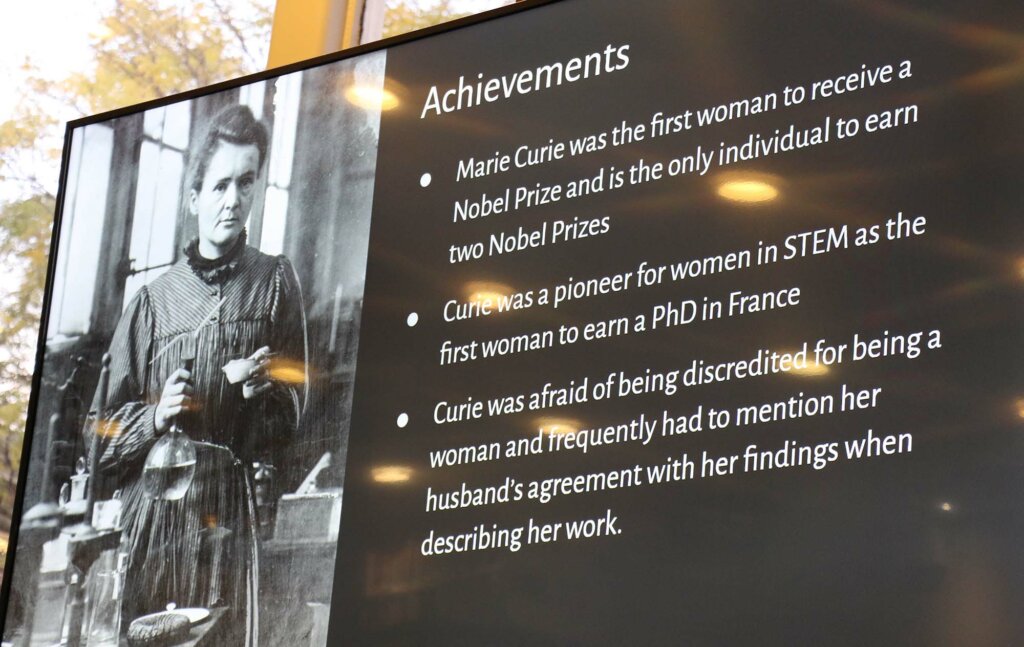
In 1903, Marie Curie won the Nobel in Physics for her study of radiation. In 1911, she won a second Nobel Prize, this time in Chemistry. Together with her husband, Pierre, Marie Curie was the discoverer of the elements radium and polonium. Triola said about Marie Curie, “We found her to be an incredibly influential person researching radiation. Her work has applications in physics, chemistry, and even medicine. Though Curie often struggled to get credit for her work due to her gender, Curie was the first person to win two Nobel prizes and the only person to win a Nobel prize in two different fields.”
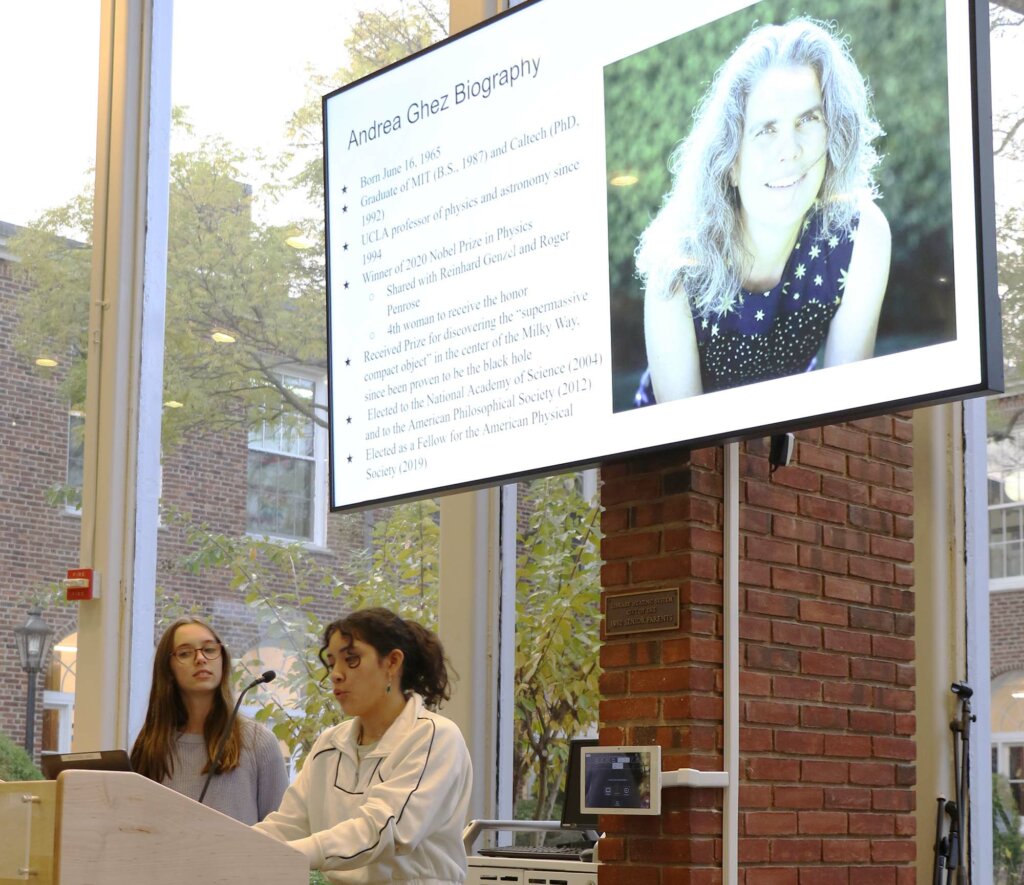
Ava Skye Rosario ’24 reported on Dr. Andrea Ghez, the discoverer of the Sagittarius A Black Hole, who won the Nobel Prize in Physics in 2020. They described it as: “Making something that was invisible — visible.”
Gaby Flinn Beane ’25 and Eleanor Kempf ’28 also presented about Dr. Ghez, who they said received the prize “for the discovery of the supermassive compact object in the center of the Milky Way.”
Maisie Schneider ’28 noted that Dr. Ghez used “the world’s largest telescopes” in developing new ways to see.
Physiology or Medicine – Tu Youyou, Katalin Karikó, May Britt-Moser
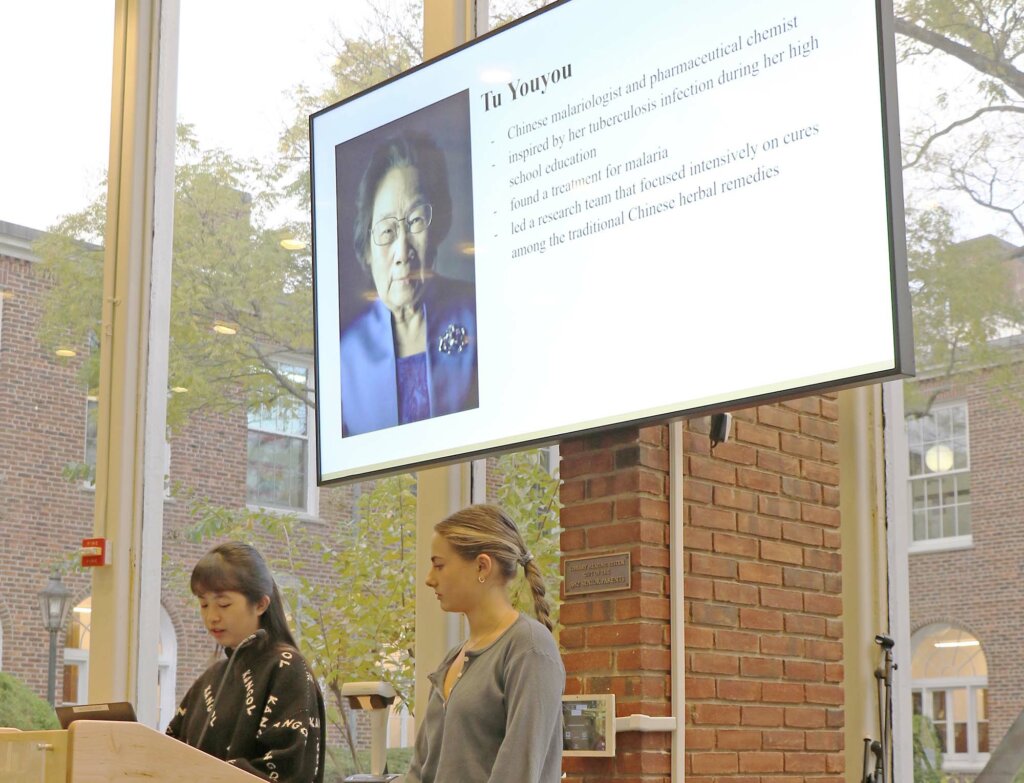
Mary Lin ’24 and Zoe Campbell ’25 profiled the Chinese scientist Tu Youyou, who won the Nobel Prize in Physiology or Medicine in 2015 for her discovery of a treatment for malaria. Through her work, she was able to extract from sweet wormwood the anti-malaria drug artemisinin.
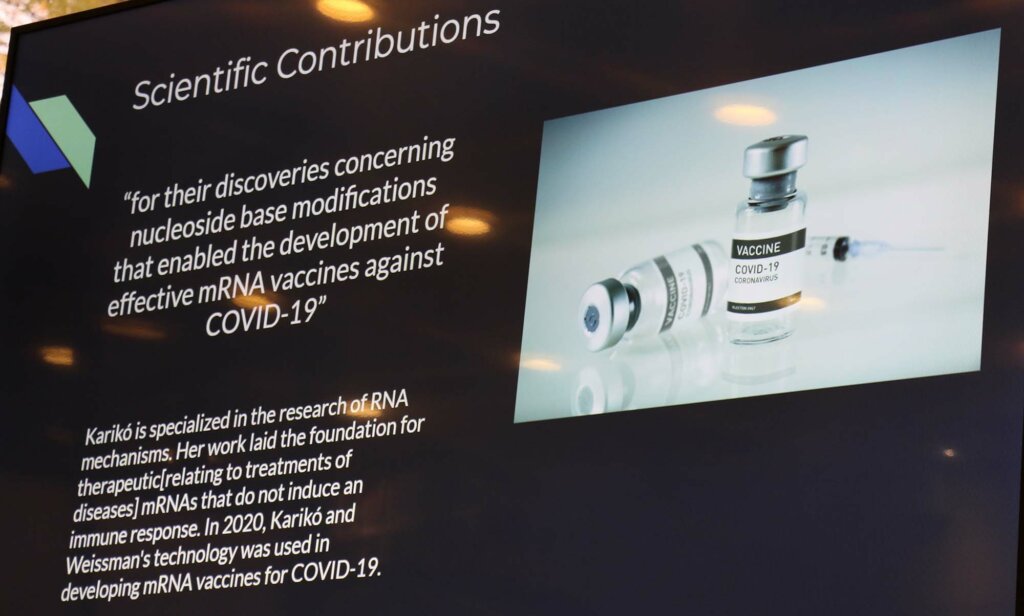
Lalitha Jayaram ’28 and Suri Sun ’26 reported on Dr. Katalin Karikó who won the 2023 Nobel Prize in Physiology or Medicine for her research “that enabled the development of effective mRNA vaccines against COVID-19.”
Jasmine Grant-Phillips ’24 and Izzy Leyton ’25 profiled the Norwegian psychologist and neuroscientist May Britt-Moser, who won the Nobel Prize in Physiology or Medicine in 2014 for her “discoveries about the cognitive function of the brain at a cellular level” in her research to better understand the brain at a cellular level.
Reflections on Nobel Winners & InFInite STEM
After the presentations, Michal Hershkovitz P16, ’18, Assistant Head of School, Academics, told the students how proud she was of the cohort. She asked them what qualities the Nobel winners had in common and heard that the scientists, who often came from modest backgrounds, had a spirit of endurance and were inspiring. Hershkovitz told the students, “I find you inspiring.”
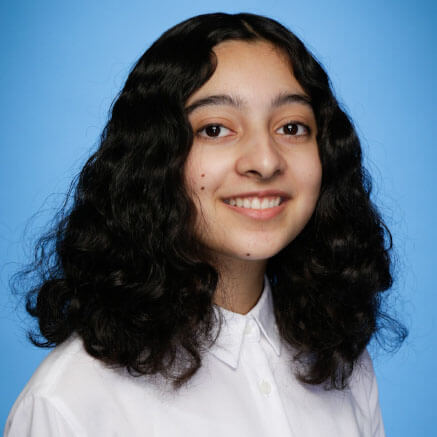
“Our teachers have worked incredibly hard to provide us with both exposure and enthusiasm for different STEM careers.”
Marisa Triola ’24
What has being part of InFInite STEM meant to the students? Triola said, “I’ve repeatedly noticed the lack of women and girls in STEM-related activities and classes. The lack of women in STEM seems to further perpetuate the problem, discouraging women of all ages from participating or even developing interest in STEM. I think it’s really important that programs like inFInite STEM exist to combat this issue. I’ve really enjoyed the activities that we’ve done during my time in inFInite STEM over the past couple years. Our teachers have worked incredibly hard to provide us with both exposure and enthusiasm for different STEM careers. We’ve gotten to speak to women leaders in STEM, including Anne Moscona, who leads a virology lab at Columbia.”
“The field of STEM that interests me most is computer science,” Triola added. “Since I completed the senior level computer science classes last year, I am currently doing independent study. I intend to pursue computer science in college next year.”


